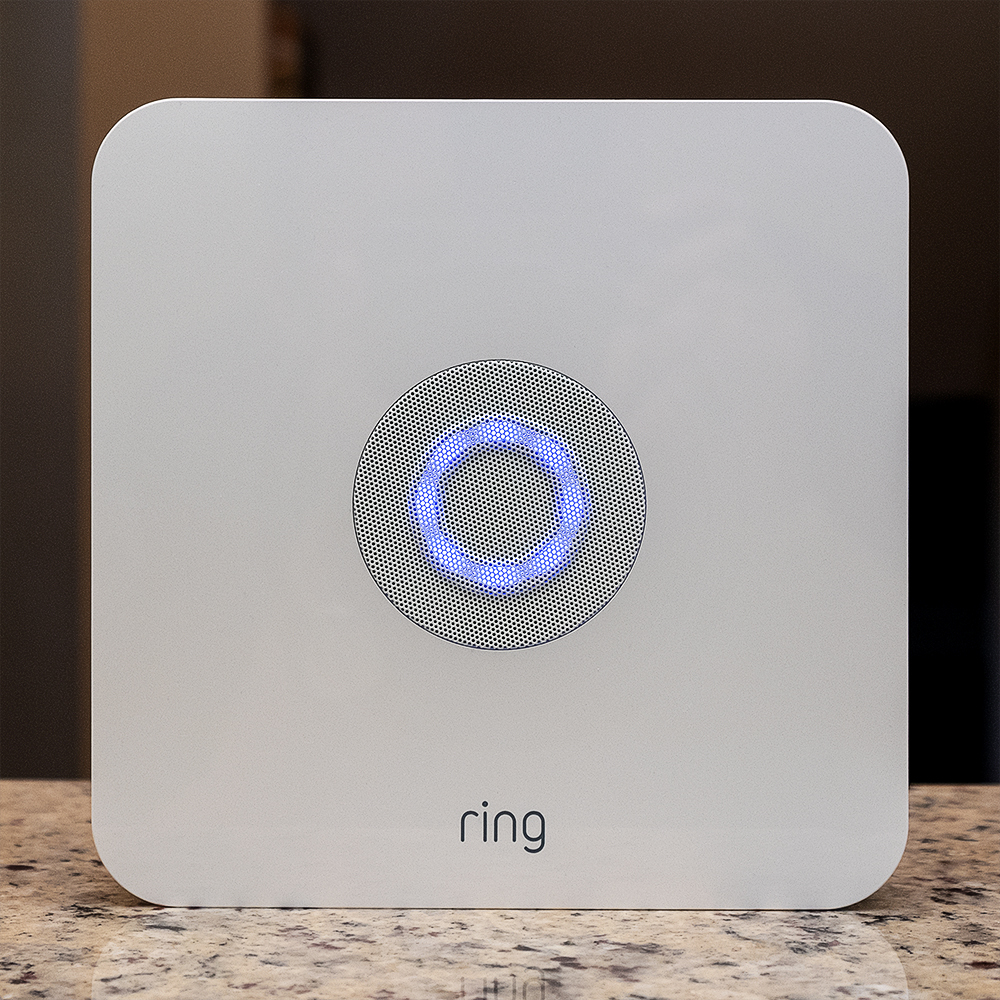7.3.18 – The Verge /cdn.vox-cdn.com/uploads/chorus_image/image/60256125/dseifert_180630_2714_0009.0.jpg)
Home security systems have been around for decades, providing a way to have your home monitored for intrusions and emergencies while you’re away or sleeping. But traditional home security systems have required professional installation, costly subscription plans, and long-term contracts that lock you in to the service. They’ve not been practical to move from home to home or for use in apartments.
Thanks to advances in sensors and other smart home technology, the landscape of home security systems is changing dramatically. It’s now possible to install a professionally monitored system in your home yourself in just a matter of minutes. You can even bring the system along with you when you move to another house or apartment. And the cost for these new systems is far less than traditional home security plans.
Ring’s Alarm, which is finally shipping to customers starting today, is the latest in these new, do-it-yourself home security systems. It’s most similar to the Secure system that Nest released last year, and uses a variety of motion, entryway, and fire / carbon monoxide sensors, along with Ring’s other home security cameras to monitor your home for emergencies and intrusions.
The Alarm system does not have as many bells and whistles as Nest’s system, nor does it have some of the conveniences Nest provides. But at $199 for the starter bundle, which includes the necessary hub, a keypad, a motion detector, a contact sensor for doors or windows, and a range extender, plus $10 per month for professional monitoring, Ring’s system is significantly cheaper than Nest Secure (which was just recently reduced to $399 for its starter kit) and is one of the least expensive home security systems you can purchase.
Aside from the obvious value proposition, Ring’s big pitch for the Alarm system is its simplicity. Though it has all of the features necessary for a proper home security system – professional monitoring, battery and cellular backup for the event of a power loss – installing the Ring Alarm in my home took less than 20 minutes and involved following the app’s instructions to get the base station on my Wi-Fi network and register each included piece. Cleverly, Ring presets the included motion detector, contact sensor, and range extender to pair with the hub that’s in the box, so getting them set up is just a matter of pulling the battery tab to wake them up and waiting a moment for the app to find them.
Installing the sensors was similarly easy: I used the included double sided tape to mount the contact sensor to my front door and the motion sensor to the corner of the downstairs living room in my home. Ring also includes the necessary screws and wall fasteners for a more permanent installation, but the double sided tape was sufficient for my needs. For this review, I added two extra contact sensors (available as $20 add ons) and mounted them on a window and second door in my home. Syncing these with the existing system was just a matter of scanning a QR code on the back of the sensor, which triggered the app to search for it. Ring says that it will preset any additional devices you order at the same time as the Alarm starting kit, which would make setting them up as seamless as the in-box sensors.
/cdn.vox-cdn.com/uploads/chorus_asset/file/11631787/dseifert_180630_2714_0001.jpg)
/cdn.vox-cdn.com/uploads/chorus_asset/file/11631797/dseifert_180630_2714_0005.jpg)
/cdn.vox-cdn.com/uploads/chorus_asset/file/11631799/dseifert_180630_2714_0007.jpg)
Ring’s motion sensors and contact sensors are much more traditional than Nest’s, which cleverly combine the two into a single device that also adds a nightlight. Nest’s base station also combines the keypad with it and adds even more motion detection sensors – Ring’s separate base station and keypad approach is almost clumsy in comparison. But it is possible to add multiple keypads to the Ring system, so you can have one at each entry way or in your bedroom if that’s a more convenient place for it. The keypad can be placed flat on a table or mounted to the wall, and uses a simple MicroUSB cable for power. Its internal battery lasts between six and twelve months, according to Ring, so it’s possible to install it in a location that doesn’t have an accessible power outlet and just charge it occasionally.
The base station is also wall-mountable and can be installed on a Wi-Fi network or connected directly to your internet router over Ethernet. It has a 24-hour battery backup plus the ability to connect to an LTE network in the event of a power outage. (The LTE connectivity is available when you subscribe to Ring’s Protect Plus monitoring service and uses AT&T’s network.) Both the keypad and the base station feature colored LED rings to signify if the system is armed or disarmed and have built-in speakers to sound the alarm in the event of an emergency or intrusion.
All told, installing the Ring Alarm in my home was one of the easiest and most painless smart home gadget installations I’ve ever experienced.
/cdn.vox-cdn.com/uploads/chorus_asset/file/11631795/dseifert_180630_2714_0006.jpg)
Ring provides 24 / 7 professional monitoring of the Alarm system through its Protect Plus service, which will automatically notify authorities and emergency services if there’s an intrusion or crisis detected. The service will alert you and other emergency contacts you set via phone and then dispatch emergency personnel as needed. Though the Ring Alarm will provide push notifications to your mobile device without the additional monitoring service, having the service ensures that emergency services are deployed automatically whether you see the push notifications or not.
Like the hardware, Ring’s Protect Plus service is significantly less expensive than other options. It costs $10 per month and has no long term contract commitments. Nest offers a similar service, but it starts at $19.99 per month with a three-year contract and jumps to $29.99 per month if you opt for no commitment. ADT, one of the largest traditional home security services, has plans that start at $28.99 per month and requires a three-year commitment.
In addition, Ring’s Protect Plus service includes unlimited cloud storage for Ring’s various doorbell and security cameras, so if you have a Ring Doorbell or outside camera already installed, you don’t need to pay a separate fee to get the most out of it.
The Ring Alarm system has three different modes, which can be set via the keypad or through the iOS and Android apps. There’s the standard disarmed mode that turns off all of the monitoring; an away mode that watches all of the installed sensors for intrusions; and then a “Home” mode, which by default will monitor sensors installed on entryways, but ignores motion inside the house. I’ve used the latter mode as basically a night or sleep setting, since during the day my family moves in and out of the house a lot and would constantly trip the door sensors.
Setting the Ring to away will trigger a customizable countdown timer (from 30 seconds to 3 minutes), to give you time to cancel the alarm or exit the home. It will then push a notification to your phone when the system is armed, as well as announce audibly through the base station and keypad in the home that it has been armed. The system will also push notifications when the alarm is triggered via motion or through an entryway, as well as when it’s disarmed. In my experience, the push notifications were near instant to my device, but I would not want to rely on them in lieu of the professional monitoring, as they would not reach me if my phone had no service or was otherwise inaccessible. The only thing Ring is missing compared to a system from ADT is the ability to detect when a glass windowpane is broken, though it’s worth noting that Nest’s Secure system doesn’t offer this feature either.
/cdn.vox-cdn.com/uploads/chorus_asset/file/11635813/ringalarmapp_3up.jpg)
Aside from the app and the keypad, there isn’t currently another way to set the system. In comparison, Nest’s system can be set via key fobs, which are quicker and easier than punching in PIN codes or opening an app, or voice through the Google Assistant. Ring says that integration with Alexa will come down the road, but it is not available at this time.
Though the Ring Alarm system covers the bases for a home security setup, there’s a lot of room for integration with other smart home products that Ring has left on the table. For example, it’s not possible to use the Ring’s motion or contact sensors to trigger lights or adjust a smart thermostat when you leave or come back home. This is despite the fact that the Ring Alarm sensors are based on Z-Wave technology, which is a widely used smart home standard.
If you do have smart lights and want to control them with a contact sensor or motion detector, you will need to install separate ones in addition to Ring’s, which can make your front door look like it’s grown barnacles with all of the sensors installed. Another simple integration would be to set a smart thermostat to its away mode when the Alarm is set to away, and then switch it back to its home mode when the Alarm is disarmed, but that’s currently not possible either.
/cdn.vox-cdn.com/uploads/chorus_asset/file/11631791/dseifert_180630_2714_0004.jpg)
/cdn.vox-cdn.com/uploads/chorus_asset/file/11631789/dseifert_180630_2714_0002.jpg) All of these limitations make the Ring Alarm feel less like a cohesive part of an integrated smart home and more like a bolt-on appendage that requires its own app and accessories. For its part, Ring says that smart home integrations are coming, but it wanted to make sure that it had nailed down the security aspect of the system before adding to it. The company says it plans to add integrations with lighting, door locks, and other smart home gadgets down the road, but it wouldn’t provide a timeline for these options when I asked.
All of these limitations make the Ring Alarm feel less like a cohesive part of an integrated smart home and more like a bolt-on appendage that requires its own app and accessories. For its part, Ring says that smart home integrations are coming, but it wanted to make sure that it had nailed down the security aspect of the system before adding to it. The company says it plans to add integrations with lighting, door locks, and other smart home gadgets down the road, but it wouldn’t provide a timeline for these options when I asked.Despite the lack of integrations with other devices and its sometimes too-simple approach, I find it hard to fault the Ring Alarm in any significant way. It’s provides an easy way to add a professionally monitored security system to your house or apartment for a cost that significantly less than other options.

